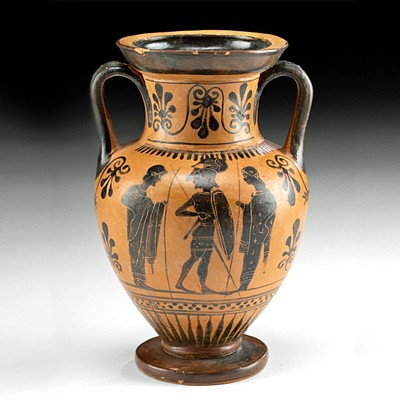Published / Exhibited Roman Glass Unguentarium
About Seller
686 S Taylor Ave, Ste 106
Louisville, CO 80027
United States
Selling antiquities, ancient and ethnographic art online since 1993, Artemis Gallery specializes in Classical Antiquities (Egyptian, Greek, Roman, Near Eastern), Asian, Pre-Columbian, African / Tribal / Oceanographic art. Our extensive inventory includes pottery, stone, metal, wood, glass and textil...Read more
Two ways to bid:
- Leave a max absentee bid and the platform will bid on your behalf up to your maximum bid during the live auction.
- Bid live during the auction and your bids will be submitted real-time to the auctioneer.
Bid Increments
| Price | Bid Increment |
|---|---|
| $0 | $25 |
| $300 | $50 |
| $1,000 | $100 |
| $2,000 | $250 |
| $5,000 | $500 |
| $10,000 | $1,000 |
| $20,000 | $2,500 |
| $50,000 | $5,000 |
| $100,000 | $10,000 |
| $200,000 | $20,000 |
About Auction
Mar 9, 2023
Artemis Fine Arts info@artemisgallery.com
- Lot Description
Roman, Imperial period, ca. 1st to 3rd century CE. A wonder to behold; the most astonishing example of iridescence in Roman glass that we have ever seen! A captivating candlestick unguentarium free-blown from originally translucent glass. Brilliant metallic and neon hues puddle across the smooth surface of the flattened body, elongated neck, and flared spout, not only causing the glass to appear opaque but also creating a mesmerizing display of uncommon elegance, the simplicity of the vessel's form highlighted by the psychedelic effect of the iridescence. Candlestick unguentaria appear as early as Augustan times and gained popularity throughout the second half of the first century, with large quantities of them being found at Pompeii and Herculaneum. They were typically used for holding scented oils and perfumes; the most popular scents of which were saffron, marjoram, and roses. Once a daily object in a Roman home, this example is now a jaw-dropping testament to all the opulence and glamor of Ancient Rome! Size: 2.3" W x 4.6" H (5.8 cm x 11.7 cm); 5.2" H (13.2 cm) on included custom stand.
Most scholars agree that Roman glass was of the highest quality - both aesthetically and technically - among the ancients. While glass making had been practiced for centuries, glass blowing was invented in the Roman-controlled Holy Land in the 1st century BCE. This innovative technology revolutionized the artform. We can appreciate such a wide variety of forms and shapes, because the medium of glass has unique physical properties that make for so many more possibilities than metal or clay. Roman glassmakers reached incredible artistic heights with both free-blown vessels and mold blown forms and decorations.
Exhibited in “Ancient Glass: Selections from the Richard Brockway Collection” at the Hallie Ford Museum of Art at Willamette University, Salem from March 10 to May 19, 2007 and “Glass of the Ancient World” at the Vero Beach Museum of Art, Florida from October 11 to December 28, 2008.
Published in “Ancient Glass: Selections from the Richard Brockway Collection.” Hallie Ford Museum of Art at Willamette University, Salem, 2007; “Glass of the Ancient World.” Vero Beach Museum of Art, Florida; and “Antiques & Art Around Florida,” Fall 2009 – Winter 2010. “Collecting Ancient Glass” by Richard Brockway with Lynette Macleod, pp. 26-27, 44-45, 47.
Provenance: private Vero Beach, Florida, USA collection, acquired before 2003
All items legal to buy/sell under U.S. Statute covering cultural patrimony Code 2600, CHAPTER 14, and are guaranteed to be as described or your money back.
A Certificate of Authenticity will accompany all winning bids.
We ship worldwide and handle all shipping in-house for your convenience.
#177744Condition
Small nick to rim edge, but otherwise intact and in overall excellent condition. Incredible iridescence. Pontil mark on underside of base. A pontil scar or mark indicates that a vessel was free-blown, while the absence of such a mark suggests that the work was either mold-blown or that the mark was intentionally smoothed away or wore away over time.
- Shipping Info
-
All shipping is handled in-house for your convenience. Your invoice from Artemis Gallery will include shipping calculation instructions. If in doubt, please inquire BEFORE bidding for estimated shipping costs for individual items.
-
- Buyer's Premium



 EUR
EUR CAD
CAD AUD
AUD GBP
GBP MXN
MXN HKD
HKD CNY
CNY MYR
MYR SEK
SEK SGD
SGD CHF
CHF THB
THB














